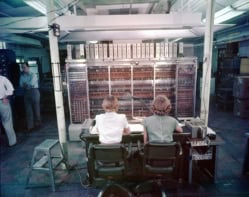Quantum Physics for Poets
Leon Lederman and Christopher Hill
2011 Prometheus Books £24.95/ $28.00hb 338pp

My immediate response to the title of Quantum Physics for Poets is “I am not worthy.” Although I have written a couple of limericks and a particularly dire sonnet, I am hardly a poet. Luckily, the book’s target audience is not actually so limited. Instead, the authors’ stated aim is to introduce quantum physics in a way that enables arts students – and presumably poets are regarded as the ultimate of that ilk – to get their heads around this truly mind-bending subject.
With this principle in mind, I was a little disappointed with the verbose introduction, in which drawn-out parallels are made with revolutions in the arts and politics – as if to prove that quantum physics is particularly suited to the intellectual rebel and make it more palatable to arty types. This seems rather condescending. The introduction also reflects a problem that reoccurs throughout the book. Although their intent is to present information in a non-technical way, authors Leon Lederman and Christopher Hill struggle to detach themselves from their jargon. Theoretical physicist Hill and Nobel-prize-winning particle physicist Lederman have had a long involvement in the public understanding of science, but demonstrate here how difficult it is for science professionals to understand the worldview of the non-scientist.
As an example, I find it difficult to believe that anyone with a non-scientific background would be comfortable with this sentence from the introduction: “Since the location of June can be deduced without measuring the electron Molly, whose properties are correlated by the initial quantum state of the radioactive parent particle, the properties of the particle arriving at Alpha Centauri must seemingly have an objective reality.” I can imagine an awful lot of poets (and other people) going “Huh?”.
After the introduction, we are eased into the quantum world with a brief historical exploration of classical physics. Galileo and Newton feature heavily here, providing a good mix of historical context and basic science. Occasionally, though, the history is something of a caricature; for example, we are told that Galileo dropped balls off the leaning tower of Pisa, an event that most historians of science consider unlikely. The exploration then moves on to cover light, which introduces the reader to the “ultraviolet crisis” – the prediction from 19th-century electromagnetic theory that all atoms should emit vast quantities of high-energy light – and the origins of quantum physics.
As the book’s scientific side comes to the fore, the historical context is downplayed, though we do get occasional snippets. I found it particularly delightful to discover that Max Born was Olivia Newton-John’s grandfather. But again, there is something of a tendency to tiptoe around historical accuracy. So, for example, we hear that in 1685 the Danish astronomer Ole Rømer’s calculations “yielded the first precise measurement of the speed of light, a whopping 300,000,000 m s–1“. In reality, Rømer’s value was closer to 220,000,000 m s–1. Suggesting otherwise condenses history a little too much.
Once we enter the 20th century, the science is given considerably more opportunity to develop, so the reader is taken with some care through Planck’s idea that radiation should be split up into “bunches, or quanta”. An interesting revelation in this section is that Planck did not really see this as an observation about light itself, but rather a description of the action of the atoms in a black body that is radiating light. Soon, Einstein enters the picture, and from this point on, a key part of the book’s message is the “shock of the new”. Looking back, it is hard to imagine just how much of a departure from classical thinking was required to begin to grasp quantum theory, and Lederman and Hill make sure that we really understand that the culture shock among physicists was immense. Indeed, some – Einstein and Schrödinger being two obvious examples – were never comfortable with its implications.
To get this far has taken only around one-third of the book. Now we plunge into the structure of the atom, matrix mechanics, the uncertainty principle and the Schrödinger equation. A whole chapter is dedicated to quantum entanglement and its implications, with an unusually detailed exploration of Bell’s theorem – a topic that is often considered too confusing for the general reader, as the authors demonstrate here. After exploring Dirac’s relativistic expansion of the Schrödinger equation and a quick tour of Feynman’s sum-over-paths approach, the book concludes with a rapid crescendo of supersymmetry, holographic universes, quantum gravity and string theory, climaxing with a brief introduction to some of the new quantum technologies of quantum cryptography and quantum computing.
Throughout the book, I get the impression that it is essentially a collection of physics lectures for arts students, generated by simplifying standard introductory physics lectures. This is acceptable for an actual course, for students who are prepared to sit through it to get their credits, but it does not work as well as a science book for the general reader. Such “science-for-the-arts” courses are quite common at US universities, but even if this were the target audience of this book, the authors could take lessons in how to go about it from Richard Muller’s superb Physics for Future Presidents, while a more general audience would benefit much more from the approach of a title such as Marcus Chown’s Quantum Theory Cannot Hurt You. Unfortunately, poets have not been well served here.
This is, nonetheless, a good book. Lederman and Hill provide the reader with plenty of introductory meat on the development of quantum physics and they really bring out the startling surprises at the heart of it. But the approach they take is not for poets. It would be much better targeted at high-school physics students to help prepare them for university physics. Rather than quantum physics for poets, this is quantum physics 101 lite. That is a useful book, and in that role I would heartily recommend it. But it doesn’t do what it says on the tin.



